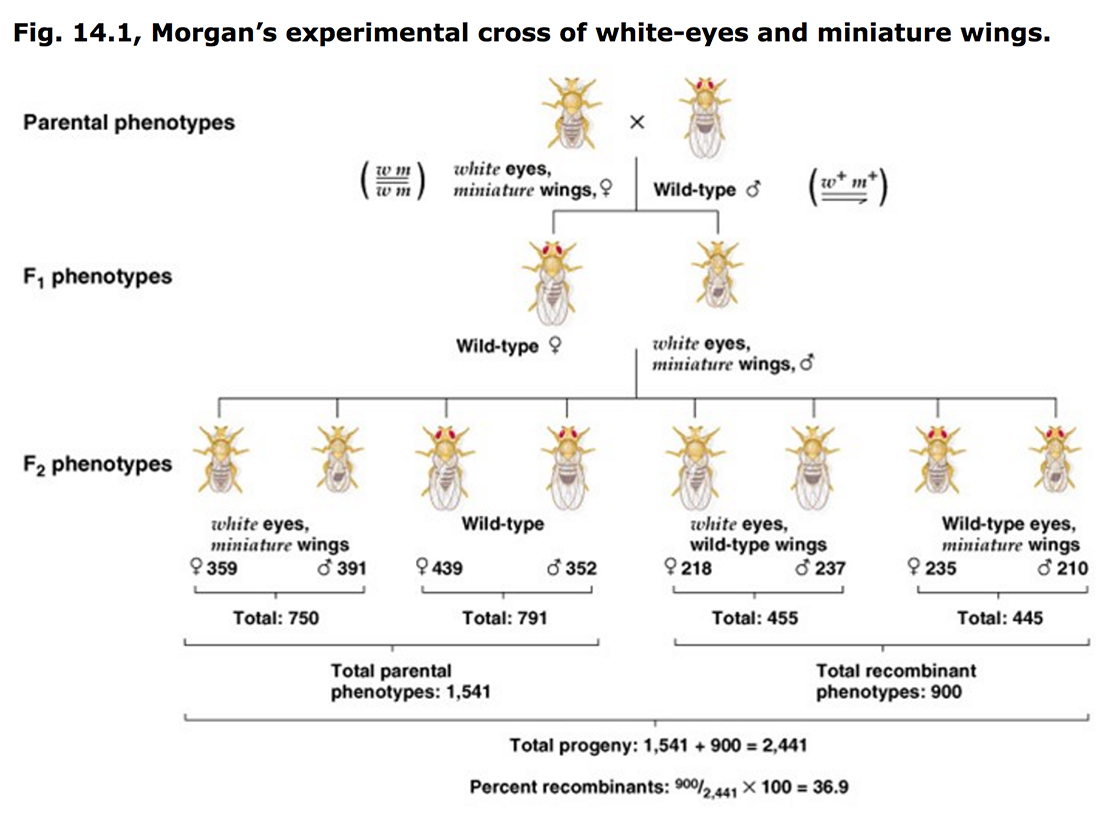Linkage and recombination are phenomena that describe the inheritance of genes. A linkage is a phenomenon where two or more linked genes are always inherited together in the same combination for more than two generations. The recombination frequency of the test cross progeny is always lower than 50%. Therefore, if any two genes are completely linked, their recombination frequency is almost 0%. The phenomenon of linkage was studied by the scientist T.H. Morgan using the common fruit fly or Drosophila melanogaster.
Suggested Videos
Morgan’s Experiment

Image Source: biotech.gsu
Morgan picked Drosophila melanogaster as his subject for the following reasons:
- He noticed a white-eyed male drosophila instead of the regular red eyes.
- It was small in size
- They have a short lifespan and so many generations can be studied in a short time frame.
- They have a high rate of reproduction
He crossed a purebred white eyed male with purebred red-eyed female. As expected following Mendel’s laws, the F1 progeny were born with red eyes. When F1 generation was crossed among each other, the ratio of red-eyed to white eyed progeny were 3:1. However, he noticed that there was no white- eyed female in the F2 generation.
To understand further, he performed a cross between a heterozygous red-eyed female with a white-eyed male. This gave a ratio of 1:1:1:1 in the progeny(1 white eyed female, 1 red eyed female, 1 white eyed male and 1 red eyed male). This made Morgan think about the linkage between the traits and sex chromosomes. He performed many more crosses and determined that the gene responsible for the eye color was situated on the X chromosome.
You can download Principles of Inheritance and Variation Cheat Sheet by clicking on the download button below

Types of Linkage
Linkages are primarily of two types: Complete and incomplete
- Complete Linkage: When the combination of characters appears together in more than two generations in a regular manner, it is called as a complete linkage. Due to this complete linkage, only two types of gametes are formed. Example: Drosophila melanogaster
- Incomplete Linkage: When there is an incomplete linkage, new gene combinations are formed in the progeny or offsprings. This occurs due to the formation of a chiasma or crossing over between the linked genes.
Linkage Significance
- Due to the linkage between genes, desired characters cannot be brought together by breeders. This would be possible only if the genes would sort independently.
- The characters that are linked remain so as there is no chance of recombination of the linked genes.
Sex- chromosome Linked Diseases in Humans
Diseases like haemophilia, color blindness, male pattern of baldness are sex-linked diseases. Where color blindness and haemophilia are X- linked diseases, male pattern of baldness is a Y-linked one. This indicates that the X-linked diseases will express themselves in a male whereas the female is always a carrier until both the genes are recessive in the female. Male pattern of baldness being a Y-linked trait expresses itself only in the males while females are never affected by it.
Crossing Over
This is a phenomenon where genetic material is exchanged between non-sister chromatids of homologous chromosomes which results in a new gene combination. The process of crossing over occurs in a sequence of following steps:

Image Source: socratic
- Synapsis
- Duplication of chromosomes
- Crossing over
- Chiasmata formation
- Terminalization
Solved Example for You
Q1: If the genes are completely or fully linked, what are the chances of recombination?
- 65%
- 25%
- 0%
- 100%
Sol. The correct answer is the option ”c”. If the genes are completely or fully linked, then the chances of recombination are 0%.







Leave a Reply